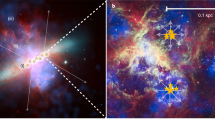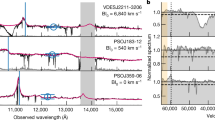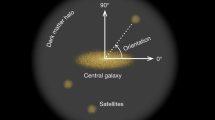Abstract
Detailed high-resolution observations of the innermost regions of nearby galaxies have revealed the presence of supermassive black holes1,2,3,4. These black holes may interact with their host galaxies by means of ‘feedback’ in the form of energy and material jets; this feedback affects the evolution of the host and gives rise to observed relations between the black hole and the host5. Here we report observations of the ultraviolet emissions of massive early-type galaxies. We derive an empirical relation for a critical black-hole mass (as a function of velocity dispersion) above which the outflows from these black holes suppress star formation in their hosts by heating and expelling all available cold gas. Supermassive black holes are negligible in mass compared to their hosts but nevertheless seem to play a critical role in the star formation history of galaxies.
This is a preview of subscription content, access via your institution
Access options
Subscribe to this journal
Receive 51 print issues and online access
$199.00 per year
only $3.90 per issue
Buy this article
- Purchase on Springer Link
- Instant access to full article PDF
Prices may be subject to local taxes which are calculated during checkout



Similar content being viewed by others
References
Gebhardt, K. et al. A relationship between nuclear black hole mass and galaxy velocity dispersion. Astrophys. J. 539, L13–L16 (2000)
Merritt, D. & Ferrarese, L. The M bh–σ relation for supermassive black holes. Astrophys. J 547, 140–145 (2001)
Tremaine, S. et al. The slope of the black hole mass versus velocity dispersion correlation. Astrophys. J 574, 740–753 (2002)
Ferrarese, L. & Ford, H. Supermassive black holes in galactic nuclei: Past, present and future research. Space Sci. Rev. 116, 523–624 (2005)
Silk, J. & Rees, M. J. Quasars and galaxy formation. Astron. Astrophys. 331, L1–L4 (1998)
Morrissey, P. et al. The on-orbit performance of the Galaxy Evolution Explorer. Astrophys. J. 619, L7–L10 (2005)
Yi, S. K. et al. Galaxy Evolution Explorer ultraviolet color-magnitude relations and evidence of recent star formation in early-type galaxies. Astrophys. J. 619, L111–L114 (2005)
Kaviraj, S. et al. UV-optical colours as probes of early-type galaxy evolution. Preprint at http://arxiv.org/astro-ph/0601029 (2006).
York, D. G. et al. The Sloan Digital Sky Survey: Technical summary. Astron. J. 120, 1579–1587 (2000)
Schawinski, K. et al. The effect of environment on the UV colour-magnitude relation of early-type galaxies. Preprint at http://arxiv.org/astro-ph/0601036 (2006).
Lauer, T. R. et al. The centers of early-type galaxies with Hubble Space Telescope. V. New WFPC2 photometry. Astron. J. 129, 2138–2185 (2005)
White, S. D. M. & Frenk, C. S. Galaxy formation through hierarchical clustering. Astrophys. J. 379, 52–79 (1991)
Springel, V., White, S. D. M., Tormen, G. & Kauffmann, G. Populating a cluster of galaxies—I. Results at z = 0. Mon. Not. R. Astron. Soc. 328, 726–750 (2001)
Khochfar, S. & Burkert, A. On the origin of isophotal shapes in elliptical galaxies. Mon. Not. R. Astron. Soc. 359, 1379–1385 (2005)
Khochfar, S. & Silk, J. On the origin of stars in bulges and elliptical galaxies. Preprint at http://arxiv.org/astro-ph/0509375 (2005).
Dekel, A. & Silk, J. The origin of dwarf galaxies, cold dark matter, and biased galaxy formation. Astrophys. J. 303, 39–55 (1986)
Di Matteo, T., Springel, V. & Hernquist, L. Energy input from quasars regulates the growth and activity of black holes and their host galaxies. Nature 433, 604–607 (2005)
Croton, D. J. et al. The many lives of active galactic nuclei: cooling flows, black holes and the luminosities and colours of galaxies. Mon. Not. R. Astron. Soc. 365, 11–28 (2006)
Hopkins, P. F. et al. Black holes in galaxy mergers: Evolution of quasars. Astrophys. J. 630, 705–715 (2005)
Springel, V., Di Matteo, T. & Hernquist, L. Modelling feedback from stars and black holes in galaxy mergers. Mon. Not. R. Astron. Soc. 361, 776–794 (2005)
Bernardi, M. et al. Early-type galaxies in the Sloan Digital Sky Survey. III. The fundamental plane. Astron. J. 125, 1866–1881 (2003)
Boselli, A. et al. UV properties of early-type galaxies in the Virgo cluster. Astrophys. J. 629, L29–L32 (2005)
Yi, S. K. Uncertainties of synthetic integrated colors as age indicators. Astrophys. J. 582, 202–214 (2003)
Kennicutt, R. C. The global Schmidt law in star-forming galaxies. Astrophys. J. 498, 541–552 (1998)
Khochfar, S. & Burkert, A. The importance of spheroidal and mixed mergers for early-type galaxy formation. Astrophys. J. 597, L117–L120 (2003)
Acknowledgements
We thank J. Magorrian for discussions and comments. GALEX is a NASA Small Explorer, launched in April 2003. We acknowledge NASA's support for construction, operation, and science analysis for the GALEX mission, developed in cooperation with the Centre National d'Études Spatiales of France and the Korean Ministry of Science and Technology. This work was supported by the Basic Research Program of the Korea Science & Engineering Foundation (S.K.Y.). Author Contributions K.S., S. Khochfar, S. Kaviraj and S.K.Y. performed the data sampling, analysis, interpretation, model construction, and writing of the manuscript. A.B. supplied the Virgo galaxy data, and the rest of the authors contributed to the data acquisition using the GALEX satellite.
Author information
Authors and Affiliations
Corresponding author
Ethics declarations
Competing interests
Reprints and permissions information is available at www.nature.com/reprints. The authors declare no competing financial interests.
Supplementary information
Supplementary Notes
This file provides short descriptions on the semi-analytic prescription we use to make galaxy evolution models with AGN feedback and on our data selection schemes. Main sections are 1. Galaxy Formation Modelling, 2. The Virgo Cluster Data, 3. The RSF Criterion, and 4. Visual Inspection of Galaxy Morphology. (PDF 125 kb)
Rights and permissions
About this article
Cite this article
Schawinski, K., Khochfar, S., Kaviraj, S. et al. Suppression of star formation in early-type galaxies by feedback from supermassive black holes. Nature 442, 888–891 (2006). https://doi.org/10.1038/nature04934
Received:
Accepted:
Issue Date:
DOI: https://doi.org/10.1038/nature04934
This article is cited by
-
Probing galaxy evolution through Hi 21-cm emission and absorption: current status and prospects with square kilometre array
Journal of Astrophysics and Astronomy (2022)
-
Space missions for astronomy and astrophysics in Korea: past, present, and future
Journal of the Korean Physical Society (2021)
-
Sub one per cent mass fractions of young stars in red massive galaxies
Nature Astronomy (2019)
Comments
By submitting a comment you agree to abide by our Terms and Community Guidelines. If you find something abusive or that does not comply with our terms or guidelines please flag it as inappropriate.



